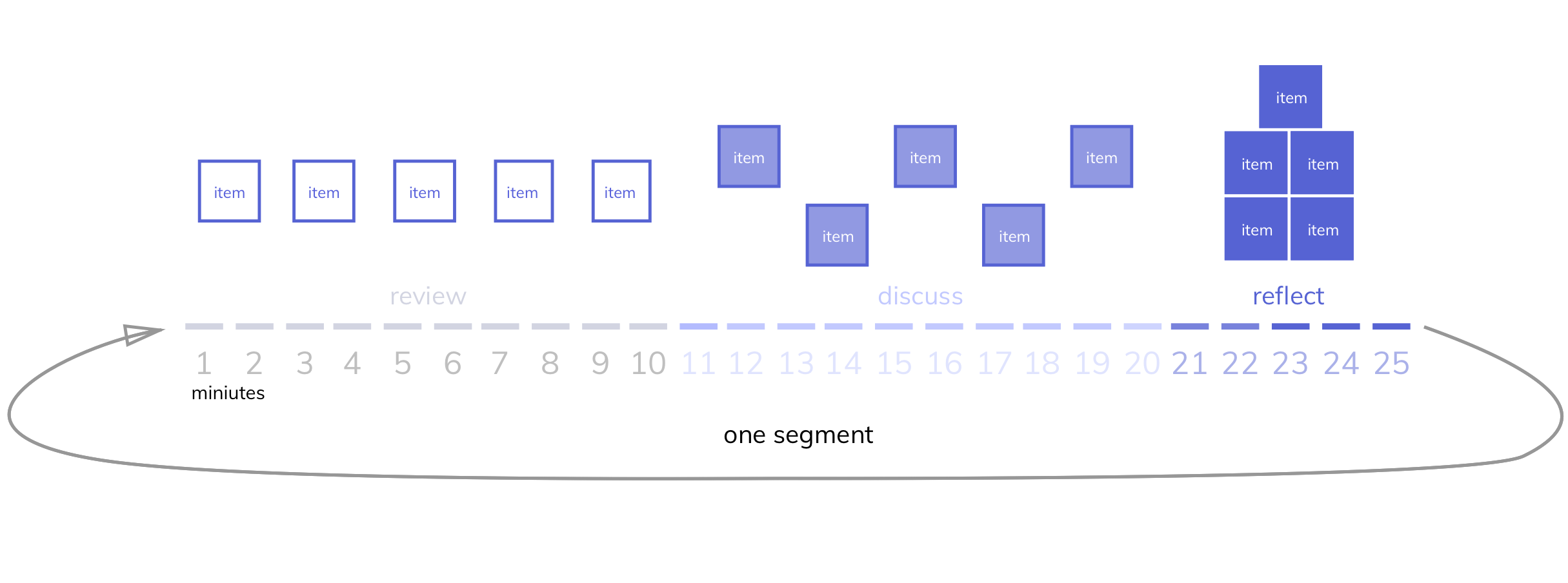How to make meetings work for your product

.png)

.png)
Working in teams is a deeply rooted part of our nature. Humans evolved in groups because we have more clout collectively.
It's much the same for product teams. The teams who frequently meet to collaborate—remotely or in person—are the ones most likely to succeed.
But, paradoxically, most product teams feel meetings are a waste of time, and some even hate them.
So what's the deal?
The thing is, meetings left unchecked can be insidious.
For the makers—designers, developers, writers, etc.—meetings disrupt flow. You can't design, program, or write well in units of hours, which means meetings scattered around in schedules can do more harm than good. For managers, time is constantly wasted sitting through hastily called, poorly planned “catch-ups” that involve too many people to yield any traction.
And for businesses, meetings are costly. A team of 80 that attends five hours of meetings per week (on the average IT salary) will cost a company $600k per year in hourly wages—a serious investment.
The human and monetary costs of poorly designed meetings are apparent. But when meetings are carefully designed, they become instrumental to the success of your product by delivering stronger ideas, strategies, and relationships.
Here, we take a look at smart methods to help you get meetings working for your product.
The process of product design involves identifying problems and then designing solutions. The problems that typically get prioritized are the ones on the outside—problems in the code, the UI, or the user experience. These customer-facing issues are the most obvious and consequently the ones that get attention.
But you need to take this approach and turn it inward, because what happens on the inside directly impacts the problems you are solving on the outside. These inside elements—like the ability of your meetings to solve problems—warrant the same approach that you would give to any design problem.
Kevin Hoffman, author of Meeting Design, recommends using the design-thinking methodology as a checklist for planning and evaluating meetings to help you find improvements. This means taking an iterative, cyclical approach to finding the optimal meeting solution.
This process involves three steps:

There's rarely one cause and one answer to a problem, which is why the design-thinking methodology is so useful for meeting design. It helps you identify issues and find solutions that are specific to your unique situation.
The one thing that meetings all have in common is that they involve people. The one challenge that people bring to meetings is their limited capacity to digest and recall the information that gets shared.
This capacity is stretched in unstructured meetings that invite ideas, opinions, and directions to be chaotically shared. Good and bad ideas get muddled together, and some people disengage while others get confused. The result is a team that walks away from a meeting with little to show for it.
As you experiment with your meeting design, you will begin to solve these types of issues. But to make your meetings really work for your product, you need to design them to support cognitive abilities. Here are three points to consider when experimenting with your meeting design.
Our working memory is thought to hold four or five new items in it at any one time. The items that get transferred into long-term memory—for recall at a later date—are the ones that get the most attention or are linked to preexisting information in our memory.
To help your team take on as much information as possible, consider dividing meetings into segments that each contain four or five related items; and make time for reflective thought and questions at the end of each segment. By doing this, you will help your team transfer more items from working memory into long-term memory by linking pieces of information and providing them with more time to process all of it.
Meetings rely on hearing as the primary mode of input for building memories. But the effectiveness of listening in creating good memories is limited because listening is hard work.
An experiment by Donald Bligh, author of What's the Use of Lectures?, showed that students listening to a lecture had heart rates that were in constant decline, which resulted in a decrease in energy and focus. After 20 to 30 minutes of listening, students began to have difficulty absorbing new information.
To account for this insight, you should limit your meeting segments of four or five items to 25-minute intervals to maintain attention. Ten minutes can be spent reviewing the items in detail, followed by a 10-minute discussion; then, you can conclude with 5 minutes of reflection before the next segment begins.

Limiting the meeting duration not only supports our attention spans but also encourages succinct communication and forces people to get to the point sooner. The result is concise meetings that are much easier to digest and recall.
Speaking and listening isn't the only channel of communication we have as human beings. Smell and taste might not be so relevant to your meeting design, but sight and touch are. Using multiple forms of communication improves comprehension because brains find more meaning by combining listening with seeing or touching. For example, visuals can provide inroads to additional levels of understanding that are not possible otherwise, and for some, that's the only way to “get it.” That's why we use graphs to demonstrate data, draw models to explain concepts, and use Post-it notes to build structures.
Encouraging the use of low- and high-fidelity prototypes in meetings is another way to engage teams for better outcomes. Also, make sure you have sketchbooks available so your team can visually share knowledge and explain ideas that are difficult to put into words.
The point of any meeting is to use a team's combined abilities to progress toward a desired goal. If your meetings don't result in action toward goals, then your meetings are failing. To make the most of your time in the meeting room, here are some basic strategies to help you elicit action.
The bigger the guest list, the longer the meeting will take and the more difficult it will be to manage. Conversely, the smaller the guest list, the faster it is and the easier it is to manage. When it comes to meetings for action, small meetings always win over big.
Let's put this into context: With three people in a meeting, there are 3 points of contact; for five people, it increases to 10 points; with seven people, it leaps all the way to 21 points. Crowded conversations make it painfully difficult to get everyone on the same page.

Consider the classic Amazon 'two pizzas' meeting limit. Two pizzas will feed about six people, limiting the links in conversations to 15, which keeps things moving at speed.
Before each meeting, you need to clearly state the problem or the goal that the meeting will address. By doing so, you give your team the opportunity to come prepared to contribute appropriately. Notification of the meeting's context will also extend the time your team has to deliberate the problem or goal, resulting in better ideas that can be explained with clarity.
A good facilitator is someone who is unbiased and has the authority to keep the conversation on track. For the best results, the facilitator should organize the agenda to open with divergent activities and close with convergent ones. This method encourages idea generation by looking at a problem from various angles, and it concludes by discussing what's feasible within the scope of the project, finishing the meeting with a decisive course of action.
Whether you like meetings or not, they're an integral part of product development, and they shouldn't be taken for granted.
Instead of condemning them as a waste of time, shift your perspective to see meetings as a design problem.
There's not a single solution to make meetings work, but when you set out to experiment and optimize your approach to meetings, you will be able to generate better ideas, strategies, and relationships.
Want to learn more about how to change organizational behavior? Check out our Q&A with Janna Bastow of ProdPad.